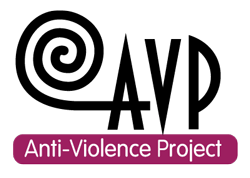Gender-based violence is an umbrella term for any violence rooted in gender-based oppression and power inequalities based on gender identity, perceived gender identity and/or gender expression. It includes any act of interpersonal, institutional, or systemic act of violence (physical, sexual, economic, emotional, spiritual, social) that devalues, and/or reinforces expected entitlement to a person’s bodies and lives. All other parts of a person’s identity or how someone is viewed, such as age, class, race, ability, geographic location, sexual orientation and status, intersect and influence how gender-based violence is experienced and committed.
Types of gender-based violence can include
- sexualized violence
- sexual harassment
- sexual assault
- rape
- transphobic violence
- homophobic violence
- intimate partner violence
Myths and Realities
MYTH 1
People who are assaulted “ask for it” by the things they wear, the places they go, the jobs they have, the things they drink, the drugs they do, etc.
Reality: Every person should be free to wear what they want to wear, go where they want to go, drink and party, and go to work without being (or fear being) assaulted.
MYTH 2
The most common substances used in a drug-facilitated assault is GHB (the date rape drug) or rohypnol (roofies).
Reality: The most common substance used in drug facilitated assaults is alcohol.
(source)
MYTH 3
People are most commonly assaulted by a stranger.
Reality: 80% of the time, people are assaulted by someone they know (more often than not it’s colleagues, family members, or friends).
Stranger 20%, Friend 10%, Family Member 28% Acquaintance 42% (Government of Canada, 2022).
MYTH 4
Most reports of sexual assault are false accusations.
Reality: False reporting of sexual assault occurs at the same rate as any other major crime, 2 – 8%. (Lonsway, Archambault, Lisak, 2009).
MYTH 5
Men don’t get sexually assaulted.
Reality: People of all genders can be assaulted; people of all genders can cause harm. 1 in 6 men experience sexualized violence (Dube, S.R., Anda, R.F., Whitfield, C.L., et al. 2005).
MYTH 6
Rape is more severe than sexual harassment and sexual assault.
Reality: The impact to a survivor is not defined by the type of violence. Trauma is not what happens to you but how your body responds (Maté, 2022).
Short-Term Responses & Symptoms
Emotional
- numbness, detachment
- anxiety, feeling fearful
- guilt
- anger
- sadness
- feeling unreal, depersonalization
- denial
- suppression of feelings
- feeling overwhelmed
- shame
- apathy
- helplessness
- hopelessness
Physical
- fatigue
- sleep disturbances (insomnia, nightmares)
- feeling frozen, inability (or difficulty) to move
- feeling short of breath
- feeling unreal, depersonalization
- numbness
- muscle aches
- teary
Social/Interpersonal
- feelings of isolation
- being avoidant
Behavioural
- feeling startled
- restfulness
- increased use of substances
- withdrawal
Mental/Cognitive
- difficulty concentrating
- distortion of time and space
- memory issues
- flashbacks
- disassociation
Long-Term Responses & Symptoms
Emotional
- irritability, hostility
- depression
- mood swings
- anxiety, fear
- grief
- shame
- feeling vulnerable
- detachment
- guilt
- helplessness
- hopelessness
Physical
- sleep disturbances, nightmares, insomnia
- appetite, digestive changes
- persistent fatigue
- hyperarousal
- feeling tense, muscle aches
- headaches
- stomachaches
- sexual dysfunction, hypersexuality
Social/Interpersonal
- feelings of isolation or intentional isolation (avoidance)
- fear of trusting others
Behavioural
- avoidance, withdrawal
- disturbances in relationships
- decreased activity level
- engagement in high-risk behaviours (self-medication, substance use, self-harm)
Mental/Cognitive
- intrusive memories/thoughts, flashbacks
- memory issues
- self-blame
- difficulty making decisions
- suicidal thinking
- hypervigilance
